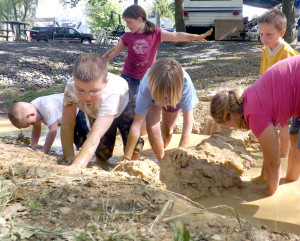Meds vs. mud: What a kid really needs
It was all a matter of perspective.
To the six young children, the muddy, clay-bottomed stream that wound through a number of campsites at the Central Pennsylvania Wesleyan Campground offered an opportunity to play. To stretch their imaginations and then put their plans into action, building a small dam and exploring for crayfish and other critters during the excavation process.
To a few of the people passing by, the scene was one of horror. The six kids were coated in various shades of brown. Their clothes were caked with clay, their hair matted with mud. These children were a mess. How could their parents allow such a thing?
To the parents who were watching from a distance, careful not to intrude in this period of unstructured outdoor play and exploration, the whole picture was one of beauty.
These children were working together with a common vision — engaged in a period of exploration that easily was worth the multiple loads of laundry and clogged shower drains that came afterward.
Many consider this the age of information. We’ve replaced large libraries of clunky encyclopedias with one-click solutions via a Google search browser. Everyone, it seems, has a Smartphone attached to one hand, ready at a moment’s notice to tackle the next major dilemma with the push of a button.
But one issue doesn’t seem to have an easy answer. Why are kids struggling more than ever with diagnoses such as Attention Deficit Hyperactivity Disorder (ADHD), Oppositional Defiant Disorder (ODD) and a whole slew of other behavioral acronyms?
Actress Jamie Lee Curtis has a solution. In various radio and television public service announcements, she pitches the importance of family mealtime, giving listeners an easy recipe for the common meatloaf.
Psychiatrists can fix the issue with a simple combination of a prescription pad and a pen.
And while either of these scenarios may offer some assistance in the battle against negative behavior as we attempt to help our children become responsible young adults, perhaps there is a solution many people overlook.
In his book, “Last Child in the Woods,” author Richard Louv warns of the negative effects of “Nature Deficit Disorder.” There is a growing amount of respectable research that shows a direct correlation with a reduction of unstructured outdoor play and an increase in long term behavior issues.
PPL senior naturalist and outdoor educator Jon Beam is one of many who sees the negative effects.
“Kids need time to play and explore outdoors without boundaries. It helps them develop a better sense of self and the world around them,” Beam said. “Video games, television, computers and the Internet can really take time away from good unstructured time exploring outdoors.”
He adds: “Making that connection with your kid and getting them excited about the outdoors doesn’t have to be hard for parents. It’s all about making the time and experiencing the outdoors together. It’s OK to admit you don’t know what something is. Spending time together looking up what made a certain animal track or identifying a bird can be just as much fun as being outdoors in the first place. Make it a game — a mystery.”
Children desperately need quality time with their families and medication is necessary in a variety of cases.
But there is something about fishing, crayfish hunting and general outdoors exploration that no dosage of Ritalin or meatloaf will ever be able to replace.

